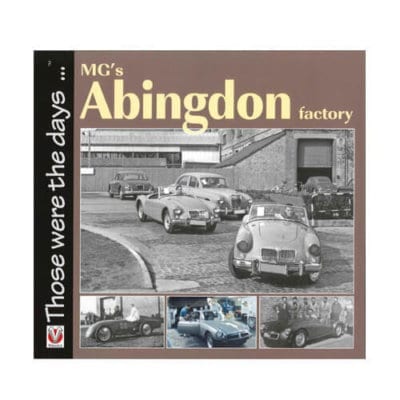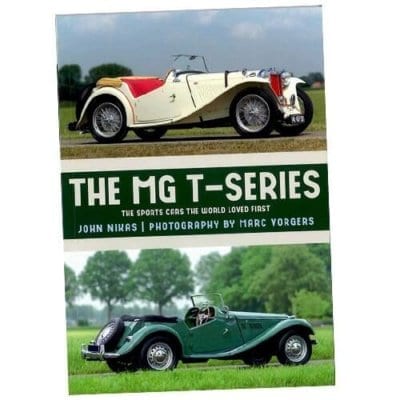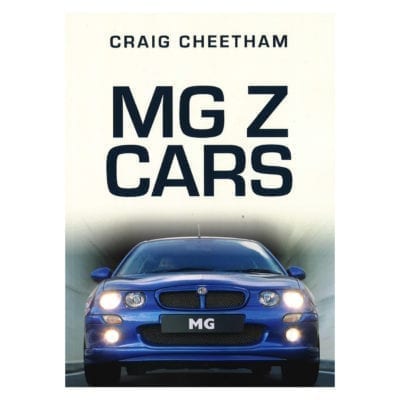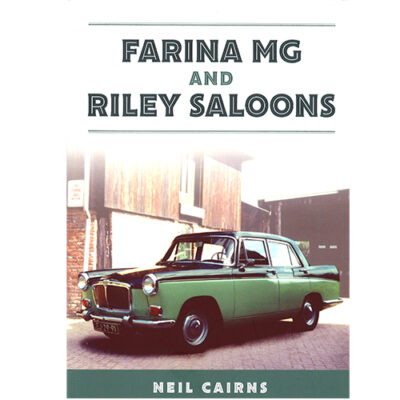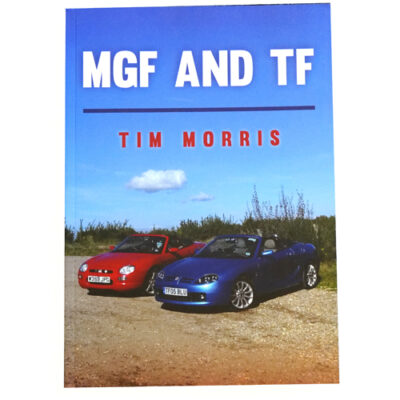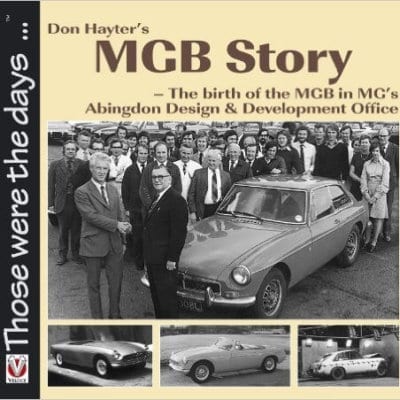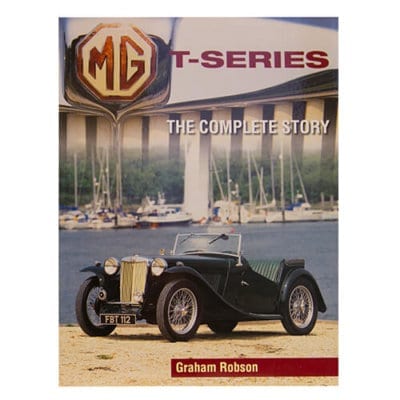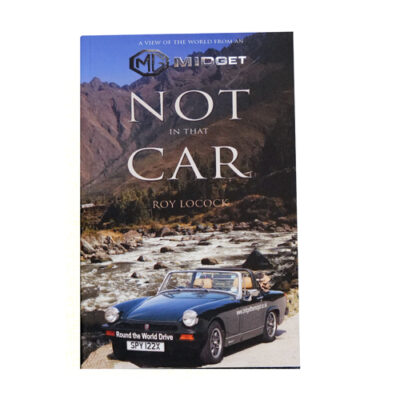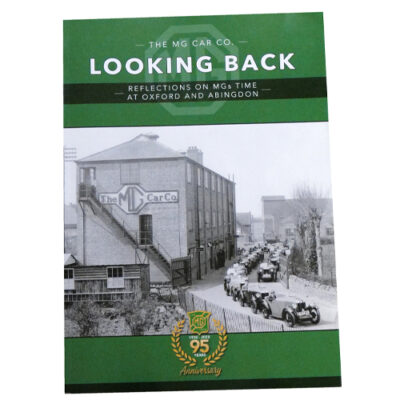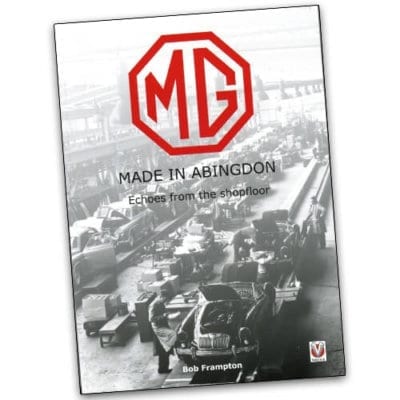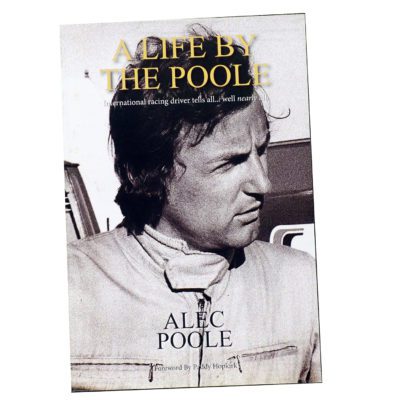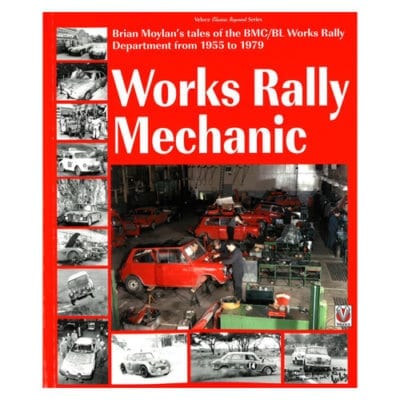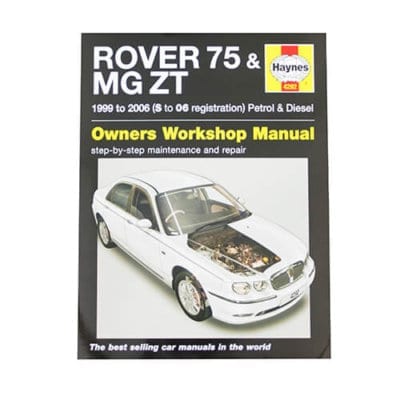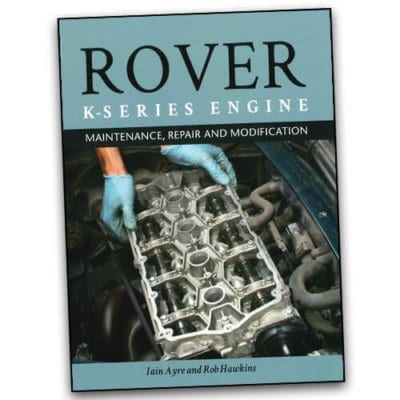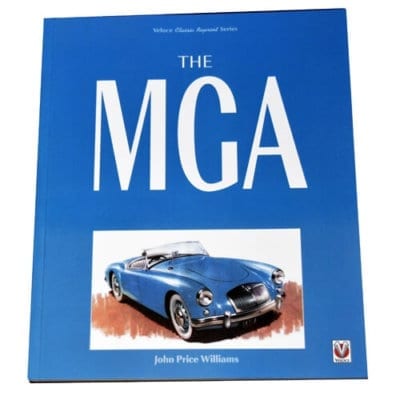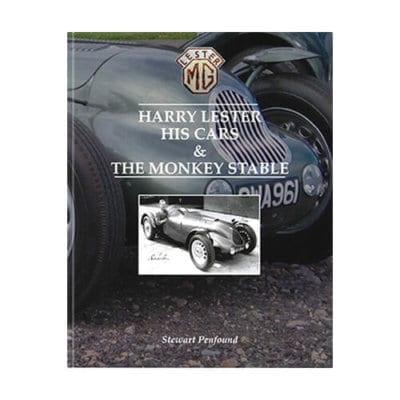Books
-
MG’s Abingdon factory
Those were the days…MG’s Abingdon factory. The 160, many never seen before, pictures in this book chronicle every aspect of the factory from its opening amidst great euphoria in 1930 to its closing amidst great recriminations in 1980
Brian Moylan started working for MG in 1950 as a mechanic in the service/repair shop. In 1955 he was drafted in to the Racing Department. which was the centre for all BMC competition work. During his time there he was fortunate enough to work on several rally winning Minis including the 1967 Monte Carlo Rally winner. Just before the factory closed in 1980 Bryan was offered the position of manager of a small satellite Morris Garages outlet. Bryan has always been involved in the MG Car Club, serving on the committee of the local Centre in various capacities
-
The MG T-Series
The book covers the technical developments such as the introduction of synchromesh gearing and hydraulic brakes as well as new engines. Due to the post-war popularity of the cars in the US after American Gls shipped examples back from Britain, modifications were made for US editions. Soon celebrities such as Clark Gable were driving them. In this readable and informative book, the author follows the development of the various MG T-Series models, incl. the prewar Midgets and the MG TC, TD and TF
-
MG Z Cars
The MG Z cars were produced at a pivotal time when the MG Rover Group separated from their previous owners BMW and stood alone in the highly competitive mass car market. In this readable book, motoring journalist and Austin Rover expert Craig Cheetham reveals the inside story of the development of the range of MG Z cars that were designed to save the company.
The book explores the formation of the Phoenix Corporation, the holding company for the MG Rover Group. It also looks at the design and engineering initiatives that would make the MG Z cars more than just a clever rebranding exercise, producing cars with lasting appeal.
The book describes the MG Z versions of the Rover 25, the Rover 45 and the Rover 75, providing insights into how each of the models was re-engineered to meet the demanding standards of MG’s heritage. It also describes the fortunes of the Z cars in motorsport, in particular the British Touring Car Championship.
The book reveals how, despite all these efforts, MG Rover eventually ran out of money, bringing an end the British-owned mass car industry.
-
MG Y TYPE SPORTS SALOON
MG Y Type by Neil Cairns
Neil Cairns is known to many in the Club for his excellent engineering knowledge particularly in relation to the MG Type. Neil has decided to put all that knowledge down in print for benefit of owners of this amazing car.
The book starts of with the development history and covers the various models, YA, YB and YT in detail. Neil has based this on his 25 years of experience of owning and driving a Y Type.
He also covers hints and tips for buying a car together with many technical tips that are invaluable for an owner. He also covers the development of the XPAG engine, covering the gearbox, chassis and rear axle. For those with a restoration project on the go, he even includes a chapter on this with detailed information on how to go about restoring and dealing with the dreaded rust.
This is a gem of a book, not only for an owner of a Y Type but also for anyone with a general interest in MG’s.
-
Farina MG and Riley Saloons
Based on the BMC Morris Oxford body, the Farina and Riley MG saloons were successors to the successful MG Magnette ZA and ZB. Introduced in November 1958, the MKIII was a combination of different parts, including engine, gearbox and rear axle borrowed from the ZB model and based on an A55 floor pan. The standard cars were produced as four separate models: the Austin A55 MkII, Morris Oxford Series 5, Wolseley 15/60 and Riley 4. The cars were updated in January 1961. The MG Magnette Mk3 and Mk4, and the Riley 4/68 and 4/72 were the up-market versions.
In this fascinating book, MG expert Neil Cairns tells the full story of these rare cars that caused controversy when they were launched due to accusations of badge engineering. However, they proved in many ways to be ahead of their time, as badge-engineered cars became the norm. Although the Riley and Farina MG saloons were criticised for not having the performance and taut handling of the previous MG Magnette model, they form an important part of the history of MG as well as that of Morris, Austin and Riley.
-
MGF and TF by Tim Morris
Launched in 1995, the MGF marked the rebirth of the classic British MG two-seater sports car. In this book, MGF enthusiast Tim Morris tells the full inside story of the development of the MGF and TF against the background of the seismic changes that were taking place in the British car industry. After the demise of the bestselling MGB and the closure of the Abingdon factory in 1980, it seemed as if the classic MG sports car had come to an end. An upgraded version of the MGB, the RV8, was introduced in the 1990s, but meanwhile designers and engineers were busy with an all-new car, which was unveiled in 1995. Developed under British Aerospace and launched under BMW ownership of the Rover Group, the MGF came under MG-Rover ownership after BMW divided the company in 2000. At this time the TF was developed and produced until the company went into administration in 2005. Here design features such as the mid-engine format and Hydragas suspension system are described, as well as the various model changes and re-designs and how the car fared against strong competition from cars such as the Mazda MX5.
-
MGF
2nd Hand book, condition excellent, first published 2000
This volume is the first in the Haynes series on modern sports cars and should appeal to lifestyle customers as well as traditional MG enthusiasts. It covers the MG heritage through to the RV8, the evolution of the MGF, its launch in 1995, mainstream developments, competition performances, record breaking with the EX253 and EX255, the EX254 Super SPorts concept car, and the future of the MGF. Customizing and tuning is also covered, plus information on performance and road tests.
-
The MGB Story by Don Hayter
This is the inside story of the MG Design office, from 1956 until its closure in 1980. Explaining how the various models were drawn, planned, and developed by the small team of engineers, it also shows how the input and control changed from Morris, Wolseley, Riley Group, Austin-Morris, and Austin Rover. The effects of the Triumph-Austin merger are detailed in model changes, alongside the effects of safety legislation, mainly imposed by the United States. Trying to remain as individual as possible during this period, MG developed record breakers and a unique Competition Department. Special cars were built and tested, and prototypes for the MGB replacement were drawn up all in parallel with the development of MG production cars using engines from any part of the company.
-
MG T-Series The Complete Story
This book tells the full story of the MG T-Series, from early production to recent Naylor and Hutson replicas.
-
MG Midget – Not in that Car
Not in that Car is the story of an Englishman who drove a 32-year old MG Midget car around the world, alone.
Roy Locock travels across Europe and down to Southern India before circumnavigating Australia and following the Pan-American Highway from Argentina to Canada. Dismissing a Taliban attack as “not being personal”, he explains the intricacies of fording through Australia’s worst floods for 30 years and is badly shaken by an earthquake in Panama City.
A highly recommended, readable account of an epic journey that will appeal to travellers and petrol heads alike.
-
MGCC Looking Back
In mid-1954 Peter applied to Morris Motor for an apprenticeship at the Cowley works. He was told he would have to wait until the new intake in September. He would then be given an interview to judge if he was suitable. Meanwhile he received a telegram to say that the MG Plant at Abingdon were looking for suitable candidates to apply for role as the Design Office Apprentice. He applied and was accepted.
Building on his Knowledge, much based on first hand experiences and talking to those involved in racing and production, he was able to do a series of thirteen articles for Safety Fast on the history of MG at Oxford and Abingdon, now pieced together into this bookazine.
A must read for any MG enthusiast.
-
MG Made in Abingdon
Here, from the memories of many men and women, is an intimate account of what it was like to work in MG’s Abingdon factory.
From tea trolley to production line and from apprentice to manager, this book includes memorable events, romance, tragedy, humour, motorsport, and the lead up to factory closure.
MG was a home-grown concept that became an international success, bringing the small market town of Abingdon onto the global map. MG – Made in Abingdon recounts the inside story of the famous factory, recognising that the most important aspect of MG’s success was its team – the tea-boys and girls, the shop floor workers, the engineers and racers, the apprentices and management. From memories of the production line to recollections of racing incidents, the untold story of MG from the men and women who worked in the Abingdon factory is revealed for the first time in a book that is both nostalgic and historically important.
Period Covered:
1929-1980 -
A life by the Poole
Alec Poole: A book with short stories, mainly about what you might call my varied, colourful and (hard to believe, I know) sometimes mischievous life in motor racing.
Unsuprisingly, in this age of political correctness, I had difficulty in finding a publisher either willing or brave enough to take on the task! However, thanks to help from my mates along the way, “A life by the Poole” has made it into print – hopefully for your enjoyment.
(Parts of the proceeds are going to Katharine House Hospice, Banbury, Oxon)
321 pages, all signed copies
-
Works Rally Mechanic – Brian Moylan’s tales
Works Rally Mechanic is the inside story of the BMC/BL Competition Department from 1955 to 1979. Brian Moylan prepared cars for international rallies for 22 years, providing service support for ‘Big’ Healeys, Minis & TR7s. This book tells of the adventures, hilarious events, hardship, winning, losing, and real danger.
-
Goldie
Dessau, Germany, 1939. A 49-year-old veteran of the Great War hobbles over to his sleek, green racing car, hands his walking stick to his mechanic and awkwardly pulls his damaged leg into the bowels of the machine. His hosts, the glamorous young drivers of the Nazi state-sponsored Silver Arrows team, share bemused grins as he rolls up his sleeves, dons an old-fashioned leather racing cap and pulls down his goggles. A few minutes later, to the astonishment of the Germans, the mostly self- funded car flashes past at over 200mph, setting a host of new international records.
Goldie moves from the brutality of an Edwardian public school, through the jungles of Ceylon and into the blood-soaked trenches of the Somme. The book follows Goldie Gardner as he emerges into the post-war world, trying to make sense of what has happened, finding friendship and love, and searching for a way to prove himself. Motor racing and record breaking seem to offer a solution, but what follows is a story of obsession that establishes him as one of the most extraordinary record breakers of all time but leads to heartbreak, betrayal and eventually taking one risk too many.
-
MG ZT Workshop Manual
Essential workshop manual covering the MG ZT from 2001 to 2005. Please note this manual does not cover the V8 ZT 260.
-
Rover K-Series engine
Getting a Rover K-Series engine properly up and running can be a difficult task, but the result is always worthwhile. Rover K-Series Engine – Maintenance, Repair and Modification is a practical guide to keeping these unique engines in fine working order. The most well-known issue with the K-Series is the head gasket, and this book identifies common faults, before giving practical advice on how best to solve them. Step-by-step guidance on long-term engine maintenance is provided, in addition to the improvements required to prevent further problems. A K-Series engine is stripped down to examine its clever and interesting structure, and is rebuilt with improvements. Authors of over twenty automotive books, Iain Ayre and Rob Hawkins have combined their knowledge to bring you this book on the Rover K-Series engine. Topics covered include the history of the K-Series; common faults and solutions; full strip down and rebuild; the Rover KV6; modifications for power and reliability; electronics and programming and comparisons with similar engine options.
-
Everyday Modifications For Your MGB, GT and GTV8
MG expert Roger Parker gives his advice on maintaining and modifying MGB, GT and GTV8 cars, with some additional reference to the MGC and MG RV8 models.
With safety information throughout, the book covers: regulations, insurance and market value for all models; routine maintenance; body and interior changes; brakes, suspension and steering; engine improvements for the original 1798cc B-series engine and other engine alternatives and finally, installing and updating electrical equipment and lighting.
-
THE MGA
This book is the definitive study, for the author has gone back to factory records and to the people who worked on the car in the ‘fifties, to find out how it was conceived, manufactured and marketed. Here is the real story of the MGA’s engineering, body styling and every aspect of the car’s development and production – including MG’s strategy to beat its competitors.In seven years of production, there were major successes and sad disappointments. The MGA was the car that was “right first time” and though the Twin Cam variant was a nightmare for the factory, it is now the most sought after model.This book tells how the sleepy Thames-side village of Abingdon became a mass-production centre for the MGA, how the MGA became one of America’s best-loved sports cars and how the MGA has become one of today’s classic cars, cherished by enthusiastic owners all over the world.
-
Harry Lester his cars & The Monkey Stable
Garage owner and expert tuner of MG cars, Harry Lester was one of the more successful sports car competitors in the late 1940s and early 1950s. In 1949 he designed and built his own car, with a rigid tubular chassis, lightweight aluminium body and utilising the favoured engine of many club racers of the time, the XPAG unit from the MGTC. So successful was the car in his hands that a trio of wealthy young amateur racers decided to form a team and commissioned him to build them a car each, plus a spare. They called themselves “The Monkey Stable” and enjoyed much success in their first year, 1952, a highlight being winning the team prize at the first 9 hours race at Goodwood. In subsequent years their fortunes changed, as did their cars, going to Kieft MGs in 1953,then back to Lesters in 1955. In the interim, the Monkey Stable drivers twice drove for the Bristol team at Le Mans, and one of their number, Pat Griffith, briefly became a works driver for Aston Martin, partnering Peter Collins in a number of long-distance events. It all ended in tragedy, however, when team founder Jim Mayers was killed at Dundrod in the 1955 TT race, only weeks after another team member, Mike Keen, had crashed fatally at Goodwood. Never before published in its entirety, this is the story of Harry Lester and his cars, together with the exploits of The Monkey Stable during their brief but significant racing career.
The story is told by Stewart Penfound, MG enthusiast and owner of one of the last of the Lester MGs made. Containing much previously unseen material from both Harry Lester’s and The Monkey Stable’s archives it is a story as much about the characters as the cars and is a significant addition to the record of motor racing immediately after the end of the Second World War.

